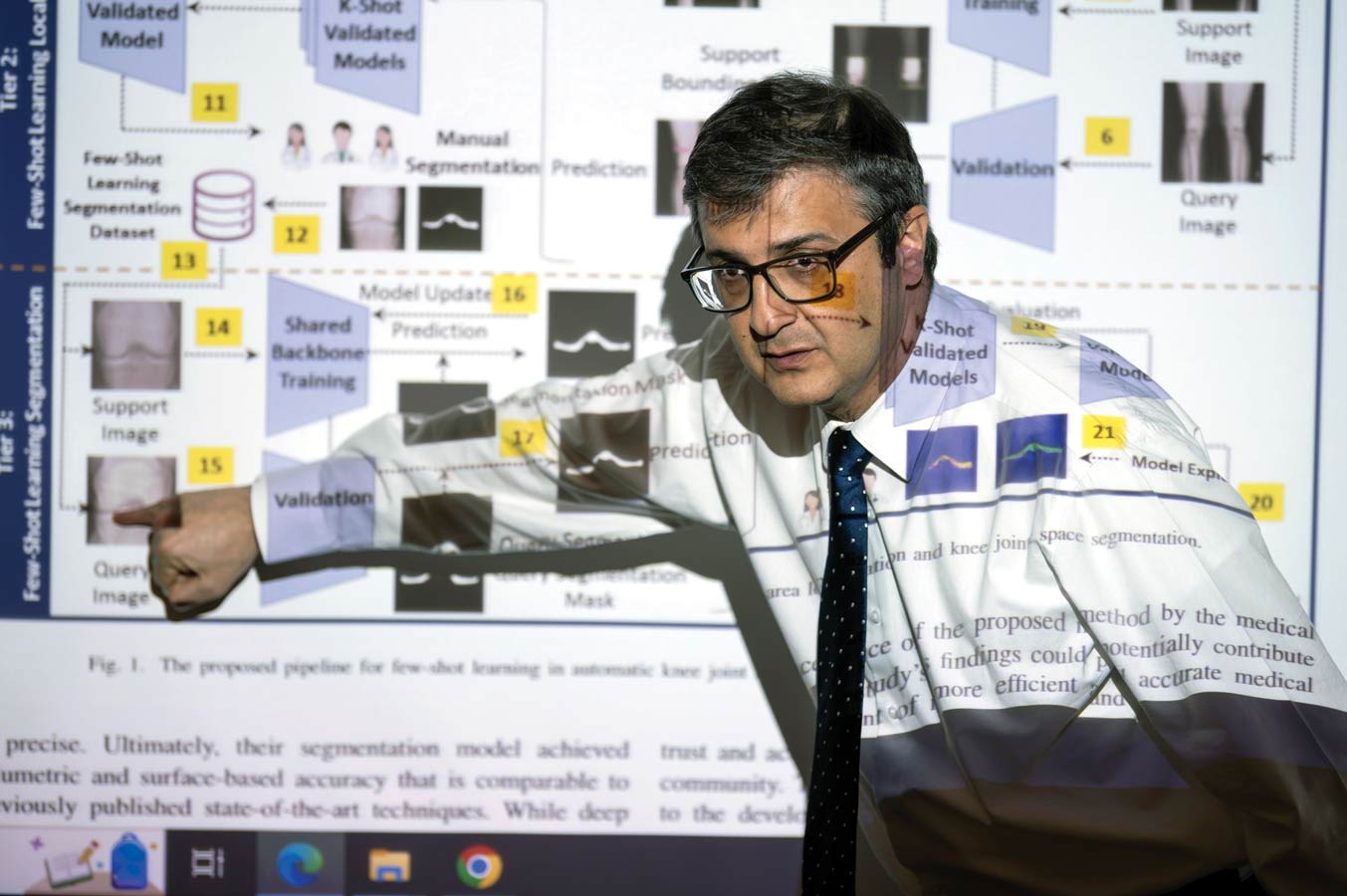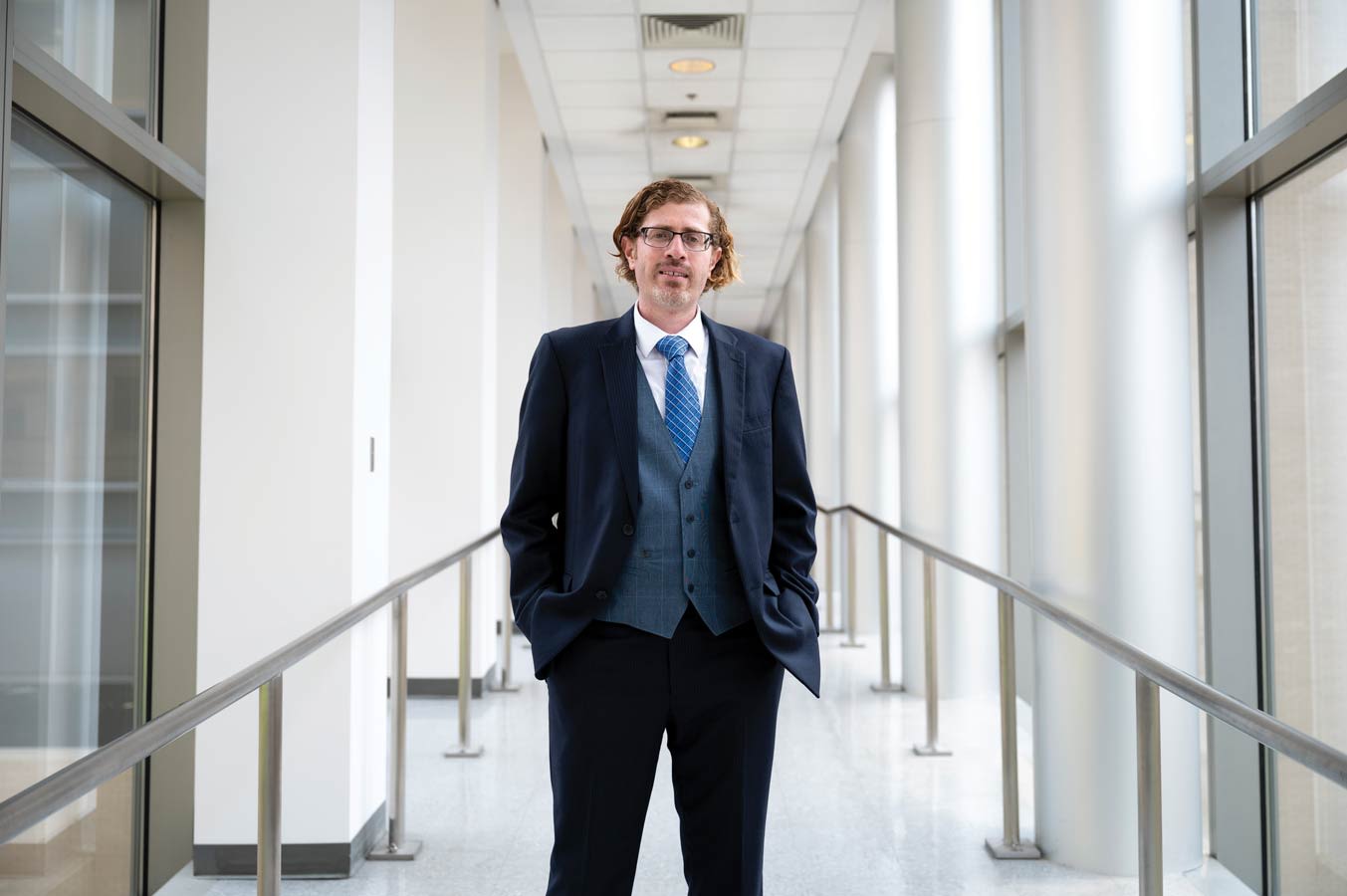University of Pittsburgh Researchers Spearhead Breakthroughs in AI
and Computational Science
Exploring Innovations Across Healthcare
and Studying the Formation of Galaxies

The capabilities of artificial intelligence (AI) have been growing steadily and, in recent years, seem to have accelerated through the curve. Advertisements now insist, “Your business can’t afford not to use AI”; the use of large language models has crept into various aspects of life; and AI keeps people comfortable by learning their preferences and adjusting their smart thermostats accordingly. Coupled with ever-increasing computing power, our daily lives – for better or worse – will only become more dependent on these often-opaque technologies.
Researchers at the University of Pittsburgh have been harnessing this computing power to solve some of today's most significant problems – some astronomically large, some as personal as a heartbeat.
Advancing Health Care Through AI
AI is used in areas of healthcare as divergent as imaging technology and predicting patient outcomes. Many of the algorithms used by AI systems share several features, one of which is the “black box,” or the idea that even the people who design the algorithms cannot say how AI arrived at any particular conclusion.
In the University of Pittsburgh's School of Medicine, Ahmad P. Tafti, assistant professor of health informatics in the Department of Health Information Management, is working to shine a light into the box with explainable AI, systems in which people, to varying degrees, have access to a system’s methods.
Tafti’s lab, Health + Explainable AI, or HexAI, aims to improve healthcare through the power of explainable AI and to share best practices across the health care discipline. His work goes far beyond the computer lab, as he combines a passion for data with his expertise in AI to solve real-world problems.
On his team, researchers from various medical and rehabilitation disciplines are developing AI models to tackle clinical challenges. From total joint arthroplasty to stroke recovery, this groundbreaking research is improving the ability of physicians to provide more accurate diagnoses and effective treatments for their patients.
Research from HexAI has also led to help for rehabilitation providers assessing the quality and consistency of intervention delivery in real-world settings. Clinically, Tafti’s work spans musculoskeletal diseases and disorders, computational orthopaedics, and computational pathology.
Guiding Tafti’s career has been his wish to do work that will make the most impact on people’s lives. “I have been on a quest to explore and solve problems that are worth it,” he said.
Some of these problems such as coronary artery disease, myocardial infarction, heart failure, and cardiomyopathy are the purview of Salah Al-Zaiti, professor and vice chair of research in Pitt’s School of Nursing. His special interest, however, lies in novel ECG signatures of cardiac ischemia, or a reduction in the heart’s ability to pump blood that, if left untreated, can develop into myocardial infarction – a heart attack.
Major heart attacks are usually easy for physicians to diagnose, but subtle heart attacks, which account for nearly 70% of all cases, require up to two hours to diagnose. They require more testing and prolonged observation and usually hospital admission.
To help ease the burden on hospitals, which sometimes need to keep people hospitalized for days for observation, Al-Zaiti and other members of a multidisciplinary team at Pitt developed an artificial intelligence system to rapidly identify heart attacks. The tool is based exclusively on EKG data from previous medical events and has been shown to help clinicians identify 37% more heart attacks in real time during initial patient screening.
Al-Zaiti has also helped develop American Heart Association guidelines for preventing and mitigating risks of exercise-related heart troubles and was part of research teams that helped to develop and implement research protocols.
Like so many Pitt faculty, Al-Zaiti is more than a research scientist. In 15 years, he’s gained experience as a clinician, a scientist, an innovator, and an entrepreneur; he has patented, among other things, his ECG technology.
When Al-Zaiti came to Pittsburgh, he said, “I wasn’t even thinking about AI.” This year, he was awarded a prestigious Fulbright U.S. Scholar Program Award from the U.S. Department of State and the Fulbright Foreign Scholarship Board for his AI work.

Ahmad P. Tafti, assistant professor of health informatics
Ahmad P. Tafti, assistant professor of health informatics

Salah Al-Zaiti, professor and vice chair of research in the School of Nursing
Salah Al-Zaiti, professor and vice chair of research in the School of Nursing
Advancing Healthcare Through AI
AI is used in areas of health care as divergent as imaging technology and predicting patient outcomes. Many of the algorithms used by AI systems share several features, one of which is the “black box,” or the idea that even the people who design the algorithms cannot say how AI arrived at any particular conclusion.
In the School of Medicine, Ahmad P. Tafti, assistant professor of health informatics in the Department of Health Information Management, is working to shine a light into the box with explainable AI, systems in which people, to varying degrees, have access to a system’s methods.
Tafti’s lab, Health + Explainable AI, or HexAI, aims to make health care better through the power of explainable AI and to share best practices across the health care discipline. His work goes far beyond the computer lab, as he combines a passion for data with his expertise in AI to solve real-world problems.
On his team, researchers and scientists from various medical and rehabilitation disciplines are developing AI models to tackle clinical challenges. From total joint arthroplasty to stroke recovery, this groundbreaking research is improving the ability of physicians to provide more accurate diagnoses and effective treatments for their patients.
Research from HexAI has also led to help for rehabilitation providers assessing the quality and consistency of intervention delivery in real-world settings. Clinically, Tafti’s work spans musculoskeletal diseases and disorders, computational orthopedics and computational pathology.
Guiding Tafti’s career has been his wish to do work that will make the most impact on people’s lives. “I have been on a quest to explore and solve problems that are worth it,” he said.
Some of these problems such as coronary artery disease, myocardial infarction, heart failure and cardiomyopathy are the purview of Salah Al-Zaiti, professor and vice chair of research in Pitt’s School of Nursing. His special interest, however, lies in novel ECG signatures of cardiac ischemia, or a reduction in the heart’s ability to pump blood that, if left untreated, can develop into myocardial infarction – a heart attack.
Major heart attacks are usually easy for doctor to diagnose, but subtle heart attacks, which account for nearly 70% of all cases, require up to two hours to diagnose. They require more testing and prolonged observation, and usually hospital admission.
To help ease the burden on hospitals, which sometimes need to keep people hospitalized for days for observation, Al-Zaiti and other members of a multidisciplinary team at Pitt developed an artificial intelligence system to rapidly identify heart attacks. The tool is based exclusively on EKG data from previous medical events and has been shown to help clinicians identify 37% more heart attacks in real time during initial patient screening.
Al-Zaiti has helped develop American Heart Association guidelines for preventing and mitigating risks of exercise-related heart troubles and was part of research teams that help to develop and implement research protocols.
Like so many Pitt faculty, Al-Zaiti is more than a research scientist. In 15 years, he’s gained experience as a clinician, a scientist, an innovator, and an entrepreneur; he has patented, among other things, his ECG technology.
When Al-Zaiti came to Pittsburgh, he said, “I wasn’t even thinking about AI.” This year, he was awarded a prestigious Fulbright U.S. Scholar Program Award from the U.S. Department of State and the Fulbright Foreign Scholarship Board for his work in AI.

Ahmad P. Tafti, assistant professor of health informatics at The University of Pittsburgh
Ahmad P. Tafti, assistant professor of health informatics at The University of Pittsburgh

Salah Al-Zaiti, professor and vice chair of research in the University of Pittsburgh School of Nursing
Salah Al-Zaiti, professor and vice chair of research in the University of Pittsburgh School of Nursing
Studying The Formation of Galaxies Through Computational Research
There is no shortage of award-winners at Pitt. Evan Schneider, assistant professor in the Department of Physics and Astronomy in the Kenneth P. Dietrich School of Arts and Sciences, is the third faculty member at the University of Pittsburgh to be named a Packard Fellow since the award’s inception in 1988. She was the first woman to do so.
Her award was in recognition of her computational research into galaxy formation. Using computer modeling, Schneider is working to unlock the mysteries of star system evolution; how galaxies form, grow, and evolve.
The complexities of such a model are mind-blowing, and the software itself was groundbreaking for the understanding of how galaxies work. Schneider wrote the code as a graduate student, despite no previous experience with computer coding.
The result was Cholla (Computational Hydrodynamics on II Architectures), a GPU-based hydrodynamics code that she is committed to keeping free and open source. Cholla simulates the evolution of galaxies to better understand how they form.
Schneider was particularly interested in the process of feedback during galaxy evolution. Many stars, after having lived their lives, explode into supernovae, blasting their materials outward – out of the galaxy – in a process known as feedback. But new stars cannot form without gas; feedback can prevent or delay stellar formation.
Comprehending the finer details of this feedback process requires extremely detailed simulations. But as Schneider continued to develop Cholla, it became more efficient and allowed for those detailed explanations better than any code before it.
The code is so powerful that Oak Ridge National Laboratory came to Schneider for assistance as it prepared to launch Frontier, the fastest supercomputer in the world.
The computer was the first to achieve an unprecedented level of computing performance known as exascale, a threshold of a quintillion calculations per second. It was a perfect match: there were massive amounts of data that could be incorporated into Cholla, but only a system as powerful as Frontier could incorporate it into a model.
Cholla was one of eight research projects chosen for CAAR, the Frontier Center for Accelerated Application Readiness program. Its goal was to optimize simulation, data-intensive, and machine learning scientific applications for exascale performance, something that hadn’t previously existed. These applications would ensure Frontier was ready when it went online for users. For the project, Schneider worked to simulate a Milky Way-like galaxy.
When she first realized that this kind of code would change the way scientists study galaxy formation, Schneider was hesitant, because she didn’t know how to code.
So she learned.
Twenty-two years later, her work was recognized with one of the largest non-governmental fellowships for research.
“As a post-doc,” she said, “you grind away and work so hard, a recognition like this is just a relief, because it tells me that all that work was worthwhile.”
To learn more about research at
the University of Pittsburgh, visit pittresearchannualreport.com

This content is paid for by University of Pittsburgh and developed by Inside Higher Ed's sponsored content team. The editorial staff of Inside Higher Ed had no role in its creation.

